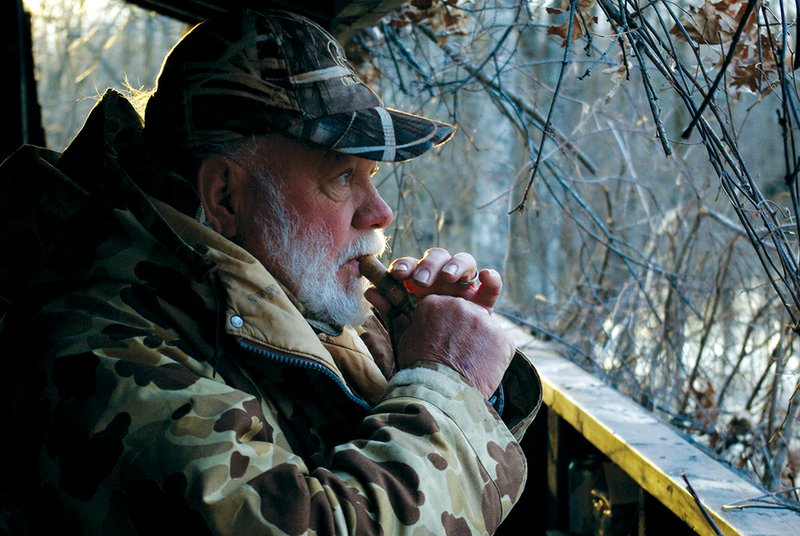5:30 a.m.
After a short boat ride, George, Bob and I arrive at the blind, which is situated in a small clearing in the flooded hardwoods. It’s still dark, so we use flashlights to illuminate our way inside. Everyone checks their shotguns to be sure they’re unloaded before handing them in; then each of us arranges his gear so it’ll be within reach when shooting time comes.
5:45 a.m.
In the half-light of predawn, we set the decoys.
“This one goes here,” Bob says, a thoughtful decision born of careful observation and past experience. Line, anchor and plastic mallard sing through the chilled air, landing with a hollow-sounding splash. The decoy bobs upright and dances in the breeze, suddenly alive.
“Now another over there, and one here in front of me,” Bob instructs.
Slowly the picture takes shape. The placid brown water gains dimension and depth as three dozen decoys are placed, each carefully gauged to complement the whole. The finished block is realistic in outline, position and color, with an open hole strategically placed so ducks will come in against the wind to light within shooting range of the blind.
We move inside and admire our creation. Weather conditions are ideal for a timber hunt — a clear sky with wisps of white clouds, no ice on the water. We see and hear ducks already as we enjoy those last few moments before shooting time.
6:10 a.m.
We’re loaded and ready. Ranger, George’s retriever, looks at us expectantly, impatient for something to happen. Two flights of wood ducks whiz by, but shooting time is a few minutes away.
6:15 a.m.
The alarm on Bob’s watch goes off. Legal shooting hours have begun — just in time. A dozen mallards come in over the timber 200 yards away, looking for a friendly neighborhood. Bob greets them with a loud, attention-getting highball call, and they wing our way.
As the ducks circle, Bob changes to a staccato feeding call. The flock falls below the treetops, but suddenly it looks as if they’ll leave. Bob gives a long, pleading comeback call, and the birds turn back. This time they’re convinced. They fall toward the water, wings cupped, feet outstretched.
“Now!” Bob shouts. A volley of gunfire erupts, and six mallards meet their maker.
Ranger waits for George’s signal, then explodes from the blind. He makes first one retrieve and then another, following his master’s hand signals until finding all six birds — five mallard drakes and a hen.
6:45 a.m.
Three woodies cruise by at light speed. George wants a drake for a mount. He swings, shoots and misses, then misses again. The wood ducks fly away unscathed. George takes a lot of good-natured ribbing.
“I think I shot overneath them,” he says.
7:10 a.m.
Bob leaves the blind and stands in hip-deep water beside a pin oak adjacent to our hiding place. Leaning against the tree in his camo hunting clothes, he’s almost invisible, and from his new spot, he can better see the ducks to gauge their demeanor and cajole them with just the right type of duck talk. Occasionally, he swirls his foot in the water, sending ripples through the decoys.
7:20 a.m.
Another flock of mallards checks our spread. I fail to notice them, and when Bob starts calling, I look around to see where the birds are. Too late I realize my mistake. The ducks see my upturned face and start backpedalling before they’re close enough for a shot.
Bob and George chide me for my mistake.
8 a.m.
More greenheads rocket by treetop high and bank sharply in response to Bob’s hail call. This time I’m ready. I keep my face down as Bob turns this way, then that, trying to keep an eye on the mallards. A staccato burst of feeding notes is the final persuader. The birds drop into the hole. George and I each kill a drake. Ranger retrieves.
8:17 a.m.
“Can you see them?” George whispers.
Heading our way is a ragged flock of fast-moving ducks.
“Greenwings, you think?”
“I’m not sure,” he replies, “but we’ll know in a second.”
They come like little rockets, each with the same loose wire in their guidance system. With astounding speed, they turn downwind. Then suddenly they bank, moving in precise unison, cupping their wings and dropping toward our decoys.
“Get ’em!” Bob shouts.
We rise to fire. The teal see us and flare, daring us to hit them if we can. Somehow, all three of us manage a single, and the rest of the fast little ducks zoom away to test the mettle of some other poor hunters.
9:30 a.m.
For almost an hour, there’s been no action. We get complacent, start talking and fail to see four mallards until they splash down in the middle of the decoys. When it happens, I’m sipping coffee; my shotgun is propped in its holder. As I try to grab my gun, the birds flush. Bob drops a beautiful orange-legged greenhead. Ranger retrieves and takes the bird to Bob. The master caller lets out a whoop and holds the bird up for us to see. The drake has a band on one leg.
10:10 a.m.
A drake wood duck zips past the decoys and apparently likes what he sees. When he makes a second pass, George is ready. He swings with the bird and makes a beautiful shot. We all admire the painted colors of the gorgeous duck when Ranger brings it into the blind. George is especially happy. He has the bird he wants for
his wall.
11 a.m.
We haven’t limited out yet, but no matter. It’s time to head home, and we’re content with the fun morning we’ve enjoyed. As we’re stooping to pick up decoys, I hear the distinctive whizzing sound of more teal passing overhead. I turn and look at Bob and George. Both have broad grins on their faces.
It’s been one heck of a great day.
